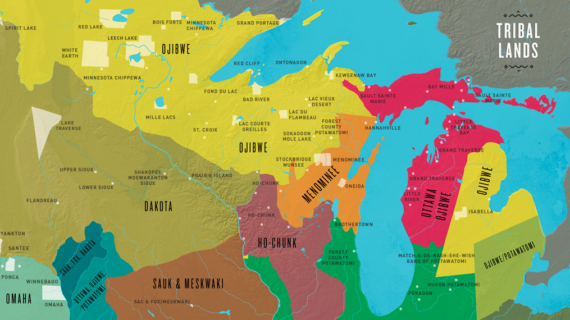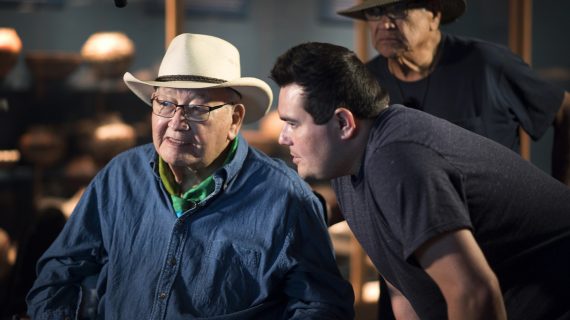– Welcome, everyone, to Wednesday Nite @ the Lab. I’m Tom Zinnen, I work here at the UW-Madison Biotechnology Center. I also work for UW-Extension Cooperative Extension, and on behalf of those folks and our other co-organizers, Wisconsin Public Television, Wisconsin Public Radio, Wisconsin Alumni Association, and the UW-Madison Science Alliance, thanks again for coming to Wednesday Nite @ the Lab. We do this every Wednesday night, 50 times a year. Tonight it’s my pleasure to introduce to you Susan Paskewitz with the Department of Entomology. She was born in Bangor, Maine, and then went to high school in Greenfield, Illinois. She went to Southern Illinois University at Carbondale for her undergraduate and master’s degree in zoology, and she went to the University of Georgia at Athens to get a PhD in zoology. Then she spent several years with the Centers for Disease Control in Atlanta and, in 1991, came here to UW-Madison. She’s given several talks here at Wednesday Nite @ the Lab. She’s got an update for us on this new Upper Midwestern Center of Excellence in Vector-Borne Diseases. We get to hear about ticks and mosquitoes and the nasty things they can spread to you and me and our pets and livestock. I’m looking forward to hearing Susan’s update. Please join me in welcoming Susan Paskewitz back to Wednesday Nite @ the Lab.
[applause]
– Thank you, Tom. Can everybody hear me okay? Is the mic working? Well, it’s a pleasure to be back at Wednesday Nite @ the Lab. I think this is one of those really cool things that we do to promote our science around campus, and it’s going to be a lot of fun for me tonight to get to talk to you about the origin of the brand-new Midwest Center of Excellence for Vector-Borne Disease. So I’m going to tell you a little bit of the story about how the center came into being, and then I want to talk about some of the things that we’re planning on doing to mosquitoes and ticks over the next few years. So, hopefully you’ll appreciate that. Before I get too deeply into tonight’s topics, though, I would be remiss if I didn’t start by saying how much I’m indebted to all of the graduate students and the postdocs who’ve participated in many of the projects that we have going, as well as, I don’t know if you can tell from this, but the undergraduates. We have a huge team of undergraduates every year who work with us out in the field, collecting all those mosquitoes, collecting all those ticks, and then, during this time of the year, they’re all in the lab extracting DNA and figuring out whether those are infected or not with all the little things that make us sick. So I’ve got a great team of people who’ve done a lot of wonderful work with us. So it’s a Center Excellence for Vector-Borne Disease. So I just wanted to start by making sure everybody defines vectors in the same way that I do.
I’m a medical entomologist, so in my community when we say vector what we mean are ticks, mosquitoes, other insects or other arthropods, a mite for example, that are involved in picking up parasites, bacteria, or viruses and transmitting them. And in the context tonight, I’m mostly going to be talking about diseases of humans, but of course they also do this for animals. So if you treat your dog for dog heartworm, then you’re well aware of the consequences of vectors feeding on animals. So I want to talk about the vectors and the role that they play in transmission of things here locally. But to tell you the story about the Center of Excellence, I actually have to speak a little more globally. Of course vector-borne diseases are really important in terms of the burden of health in a global context. And so, for example, maybe some of you have heard of river blindness, which is transmitted by black flies, a tiny fly in Africa, and with a lot of exposure, people actually lose their eyesight. A huge amount of progress has been made in reducing that, the prevalence of that disease. Another one that maybe you’ve heard of is Chagas disease.
Chagas has a lot of impact in the southern part of America and South America. And it’s transmitted by a rather large bug called the kissing bug that likes to come out and feed on your mouth, around your eyes, while you’re sleeping. The bad part about Chagas disease is that it can take a long time for you to develop symptoms. So it could be 20-30 years after you got infected with the parasite. And then, eventually, you’ll have usually trouble with your heart or trouble with your digestive system that is often fatal. So, luckily, we don’t have a lot of river blindness or Chagas disease in our part of the world, but probably you’ve heard of malaria. You know, another vector-borne disease that did used to be transmitted here in Wisconsin. So, back in the day, there’s some wonderful documents from our Wisconsin Historical Society that talk about the history of malaria here in this state. And it was the old forts and outposts where they would report what happened to the soldiers every fall.
They called it autumnal fever. Lots of the soldiers would get sick. So we have great records. But, of course, now we’ve essentially eradicated it. We don’t have much transmission here unless somebody gets infected someplace else and brings the parasite here and then happens to be fed upon by the only mosquito that can actually transmit that disease. So, globally, vector-borne diseases are very important. Of course, there are also a number of things transmitted here in the US that would be more familiar, like West Nile and like Lyme. And I’m going to talk more about those and several others as we go along tonight. But I wanted to use that as kind of segue into thinking about how what’s global and seems maybe not to affect us very much can become local.
And Zika was really the story of the year in 2016 for my community, and I’m sure that all of you heard a lot about this virus. It was something that had not occurred in the United States before, had not even occurred in our hemisphere, but it was a virus that had been discovered way back in 1947 in Africa. So it was in Uganda, and it was actually a monkey, not a human, that first showed up infected. And for a long time very few people seemed to be exposed to this virus. So it wasn’t until 2007, I think there were maybe 13-14 cases that had been documented up until 2007. If there were outbreaks, we didn’t know about it, but about that time there was a major outbreak on Yap Island. And then, another outbreak in Africa, another outbreak in Polynesia, and then it showed up in Brazil. And that was probably in 2015, perhaps even a little earlier, but by early 2016 it was very obvious that there was a major problem. And it was such an interesting story because Zika is related to other viruses that are transmitted by mosquitoes that we have a lot of information about.
So these are things like yellow fever, you’ve probably all heard of, and dengue virus, also very well-known. So it’s a relative of those viruses, but it was doing things that were very different from anything that we had ever seen in a mosquito transmitted Flavivirus before. In particular, it was sexually transmitted. This was the first time that we saw a mosquito-transmitted virus that could also be transmitted sexually. Just as a story, it was a medical entomologist who made that discovery. He was working in an area where Zika was transmitted. He went home, he gave it to his wife, they figured out that that’s what had happened, and then they published a paper on it. [laughter] You got to love scientists, right? [laughter] Get the information out there. So the sexual transmission was one really unusual aspect.
The other, of course, was this neurological invasion that caused problems in babies. So we saw microcephaly as well as other kinds of impacts on the nervous system when mothers were infected at certain points in their pregnancy. And we’d not seen that before either. That, of course, was very concerning. So, you know, one of the things that happened as a result of this occurring on the scene was UW-Madison became a real leader, and perhaps you’ve heard from some of the people on campus who did a lot of work on this virus. So we had David O’Connor, for example, and Tom Friedrich and Jorge Osorio. All had big research programs up and going pretty quickly to try to figure out some answers. The other place in our state that really got hit hard was our Department of Health Services. So when something like this happens, and the last time it happened was West Nile virus, which came into the state in 2002, when something like this happens, there’s a vector-borne disease coordinator downtown, now several of them, but at that time only one, Zip Johnson, and it was Zip’s responsibility to figure out how we were going to respond in our state.
And so that’s my poor attempt at animation. I couldn’t get it to shake because it was the phones ringing off the hook, literally. When this news story happened, she was getting call after call after call from members of the public who were really concerned if they were traveling, first of all, into areas where the virus was being circulated, what was their risk? And then others were very concerned about, you know, what about here? If I go someplace else and come back or my neighbor goes someplace and comes back, what are the chances that local mosquitoes are going to pick it up and then transfer it to me? And so she reached out to me and asked me what I thought about this. What did I know about this? We did, you know, ultimately see, in Florida and in Texas, transmission of Zika virus by local mosquitoes. So that was a result of people going someplace else, coming back infected, then their local mosquitoes fed on them, and then they went off and bit somebody else and transmitted. And we had people who traveled, so we had that part of the story here. By the end of 2016, we had 63 people who were confirmed, travelers who came back to Wisconsin with disease. And more in 2017, we also saw another nine people who showed up. So, certainly, there’s a source, right? There were people coming who could have infected local mosquitoes.
So the question for me was: do we have the mosquitoes that could actually do the job? Of course, originally, everything was possible. We have a number of different species in the state, and we didn’t know whether any of those might be capable of picking up virus and transmitting it. What we did know, though, was that in the places where there were a lot of active transmission going on, so Brazil for example, it was this mosquito, the yellow fever mosquito that you see right here, that was the main culprit. Yellow fever mosquitoes are interesting. They transmit yellow fever as well as Zika and dengue, for a couple of reasons. So there are thousands of different species of mosquito throughout the world. About 180 in North America. This mosquito does occur here in the US. And it is very adapted to people.
It really likes to feed on people over almost any other blood source that it could find. It’s also very adapted to living right around people, in very close association with people. Many of our Wisconsin mosquitoes are not like that. I know sometimes it probably feels like it. [laughter] But, you know, honestly, many of them would rather feed on whitetail deer. They would rather feed on a bird, if a bird is accessible. Sometimes you’re just in the wrong place at the wrong time. So we thought the Aedes aegypti, or this yellow fever mosquito, was most likely to be the one that would be the problem. That one does not occur here.
It’s pretty much a tropical mosquito. So where we see it in the US is way down south, Texas, Florida, or places we’d expect to see it, but not here. And I would have been very surprised if we had found it here. The one on the bottom, though, this other one, the Asian tiger mosquito, it’s a kind of a secondary vector. And it often will transmit same kinds of viruses as the yellow fever mosquito. Often doesn’t do it quite as well, so that’s a good thing. You get suppression, but it doesn’t mean that it’s not able to or can’t be an important vector in certain situations. This one has a much wider distribution in the United States. So then the question for me is: do we have that one here? Is the Asian tiger mosquito in Wisconsin? And what you do there, of course, is you go and look at all the records that we have in our museum.
We have a Wisconsin Insect Research Collection over in Russell Labs. It’s full of specimens of all kinds of things, including mosquitoes. We look in the collection, we don’t see any. We look at all the records through the years to see if anybody’s ever picked it up, never saw it. In Wisconsin, we do have now, we think, about 60 different species. So it’s not just one mosquito. Sometimes people tell me that they think there’s only one kind out there. And here, if you look at this picture, you can actually see two very different, in terms of size, which is sometimes a good tell that you’re looking at different species. One of these actually called the Gallinipper, and it’s huge.
Absolutely huge. And the other one is a smaller and more avid biter and real common. So I thought, based on the collection records, that it was really likely that we didn’t have Asian tiger mosquito in Wisconsin, and I went and looked at what was this older version of the map that you’re looking at here that was produced by Micah Hahn, who actually did her graduate work here at UW and then went out to CDC. And Micah put this together to show where we knew the mosquito had been detected. So, you know, again, you can see it a little more broadly than you’d expect for the yellow fever mosquito but not in our own particular area. So look here in Wisconsin, no records ever. But I do want to point out one thing that’s interesting when you look at this, and that is look at Indiana and look at Illinois. The red is the places where these mosquitoes are definitely established because they’ve been detected many times. So what that tells you right away is that there’s a problem with the surveillance.
It’s not a complete record, especially from Illinois. It looks like Indiana’s doing a pretty good job, but what we now know is that in Illinois it’s probably established all the way up to Peoria. So if you went and looked, almost all these counties should actually be red. The other thing we know after these last couple of intensive years of looking is notice here and also notice over here, and in both of those places there’s very intense work on mosquitoes. So lots of people looking, doing surveillance. They’ve got well-funded programs where they know. So I have say that looking at what was going on in the Chicago area made me a little nervous for southeastern Wisconsin. I was concerned that potentially we had something going on in Milwaukee or south of Milwaukee that we hadn’t recognized. We might have an established population and not know it.
And I can say that I didn’t do enough collecting, haven’t done enough collecting there to know whether it was established. So I needed to go mosquito hunting. To do mosquito hunting, you got to know a little bit about what you’re looking for. I said there were 60 species in Wisconsin, and they all have really different biologies. They do share some features, though. Probably most of you are aware of this, but I’m always surprised when I go out and talk to the public. Once in a while I’ll find that some people don’t know that mosquitoes have an aquatic stage. So the ones that are biting you are almost all the females, and the females are entirely terrestrial. They lay their eggs, and those eggs are always associated with some kind of wet spot, aquatic spot, and the eggs will hatch to product larvae, and the larvae absolutely require water for their feeding and development.
Eventually, the larvae will become a pupil stage, and then the adult will emerge, as you can see right here, form that pupa on the surface of the water and fly off hunting for a blood meal. So if we’re going to look for the Asian tiger mosquito, we have to decide if we’re going to look for the adults or if we’re going to look for larvae or we’re going to do something else. And we have a lot of different kinds of ways that we could look, a lot of tools. And so if we’re going to look for adults, here are some of the traps that we use for that. And so here’s one that I use quite a lot. This is called the CDC light trap. It’s a CO2 light trap. And in this trap what you’ve got is a little light bulb right here, and then you’ve got a cooler and we put dry ice in it. And then there’s a couple of holes punched, and very slowly over the night a little bit of CO2 leaks out of those holes from the dry ice subliming, and mosquitoes are looking for a host and the CO2 in the host’s breath is often something that they’re focusing on.
So they’ll come into the trap. There’s a little fan that sucks them down into the cage. And we’ll come back the next day and get them. These traps require a battery to run the light and the fan. And they also require carbon dioxide. So you got to have a source of dry ice, and they’ve got to be primed every day, new bunch of dry ice in, and they cost a lot of money to maintain. There’s another trap that we use for looking for West Nile virus vectors. So that’s a little mosquito called Culex, or the northern house mosquito, and that particular mosquito, we really like this one because we can collect it very selectively. If we go out with one of those light traps, we’re going to get probably 20 to 30 different species trapped in that kind of a trap.
In this other trap, what we’re doing here is looking for mosquitoes that are trying to find a place to put their eggs. And it turns out that the West Nile vector, she, for whatever reason, she likes water that smells horrible. [laughter] So we make horrible smelling water on the back deck of Russell Labs, just a block or two away. And what we do is we take these big containers, plastic containers, and we put water in them, and then we add manure and grass cuttings and a little bit of yeast, and we cap it and we let it sit there for a week. [laughter] In the sun. And then we come back and we crack the lid, and if it knocks you over, then it’s ready. [laughter] So, in this particular trap then, some of my poor students take gallon milk jugs full of this stinky water, they bait it, and then they set the little trap. And when the mosquitoes come in again, they get sucked in by a fan into a container. That doesn’t work for Asian tiger mosquitoes.
They don’t like that kind of smelly water. So we couldn’t use that kind of trap for them. The other thing about Asian tigers is they’re daytime feeders. Unlike many of our mosquitoes, which are feeding at night or when the sun goes down, or when the sun comes up, but not so much during the day, these mosquitoes really avid during the daytime. So this light CO2 trap, it’s also not the best for one of these Asian tiger mosquitoes. This trap, this is a centennial trap, is baited with chemicals that smell like a human. So they put ammonia and lactic acid in the lure, and it works fine for day-feeding mosquitoes. In fact, it was developed for yellow fever and Asian tiger. So that’s a good one. We have some of those that we use, but unfortunately, it’s very expensive.
So every one of those traps, take a guess how much they cost. Over $100 per trap. So imagine, how many different places could we even look if it’s going to cost us $100 a trap to get them out there? So that wasn’t optimal. We also thought about going out to look for the larvae, but larvae are going to be in lots of different places. This is a floodwater species. Here’s a ditch where we find some kinds of things. This is the underground catch basin system. You know, those grates by the sidewalk where the water flows off the street when it rains really hard? There’s a whole system of pipe underground to get rid of all that water so it doesn’t flood our streets. Some mosquitoes, especially the West Nile vector, really like to breed down there.
So you could go there and look for the albopictus, but that’s not a place where we would tend to think they are either. So what do we end up doing? We didn’t end up using any of those methods that I just described that we might use for other mosquitoes. What we did was take advantage of the fact that the Asian tiger mosquito and the yellow fever mosquito are container breeders. Remember that I said that they’re really tightly associated with humans. Well, one of the things that they can use is our garbage and debris. And so if we’re throwing out bottles or we’ve got a birdbath or we’ve got an old discarded tire in the woods or, in this case, what you see is a stadium cup, they will lay their eggs in that. And so what we did was buy a lot of stadium cups and a tongue depressor, and then we put water about halfway in, threw in the tongue depressor, thumbtacked it to a tree, and came back in a week and looked to see if any eggs had been laid. If they were, we took it back to the lab and we hatched them, and then we identified the larvae or the adults resulting from that. So we put out, oh, hundreds of these in different places.
And what we found, using this ovitrap is what we call it, was, guess what? We hadn’t been looking and indeed we did find it right away. Like within two weeks of deploying these traps, we found the Asian tiger mosquito in Wisconsin. And it was in southern Wisconsin. We’ve not really looked outside of here. We looked a little bit over in the La Crosse area, but we focused in the southern tier. So over in Milwaukee, Dane County, Waukesha, a number of different places. But these were the two where we actually found it right away. Our partners in surrounding states, in Iowa, also ramped up their surveillance. They were finding it in places they’d never seen it before.
Similarly, we have partners in Michigan who were finding it. And then those people who really know what they’re doing over here in Minnesota. [laughter] The Metropolitan Mosquito Control District, they reported their 18th find of Asian tiger mosquito in that city. So I don’t think they’re really widespread or very abundant, but clearly they’re being brought into our area with some regularity. You know, the question is whether they’re going to be able to make it through the winter. So we have an experiment going on right now where we have eggs out in nature, and we go out every couple of days and we see if they’re able to hatch or if they’ve been destroyed by the temperatures. And so if last week, when it was unusually cold here, you were feeling a little annoyed and like you wanted to go to Florida, just think about this, right? This is going to completely knock out the populations, I believe. I don’t think we’re going to see, at least yet, we’re not going to see them make it through the winter. If we had a couple of mild winters in a row, then I think it is possible that we could get them established and starting to reproduce. The other one that I sometimes talk about is the lone star tick.
And I think I did the last time that I gave this talk, I mentioned that that one has now popped up in a number of places in Wisconsin. But I think as well that one will not survive a really cold winter, so when we have no snow cover and icy temperatures, that should be good for knocking that one out. That’s a relief because a number of people, when they’re bitten by that tick, develop an allergy to red meat. And, of course, that’s a huge concern in Wisconsin. The only thing worse– I’ve told this joke every time I give this talk, but the only thing worse would be developing an allergy to beer or cheese. [laughter] The other thing that– So, to summarize that, what we learned, I think pretty quickly, was that there were some gaps in our knowledge about where these potential vectors of serious diseases that might be imported are even, where they exist. The other thing that happened as a result of the Zika issue was that we, in some parts of the country, realized that we were lacking in expertise in terms of what to do about it. If you did have a problem where you had lots of the vectors and you had transmission, you were going to need to implement some kind of a control program to try to protect the public. In some places where they did that, the people who were implementing the program were not well trained and didn’t quite know what they were doing.
In this one case, there was a very negative outcome where a lot of honeybees were killed when they sprayed an aerial pesticide at the wrong time of the day. So that’s something that we need to manage a little bit better. And so, as a result of that, the CDC recognized through the whole Zika episode that we were lacking information about vectors, that we were lacking trained people who could implement surveillance programs as well as control when needed, and we were lacking medical entomologists, quite frankly. You know, around the country what we’re seeing is a decline in the training of people in the old school kind of medical entomology where you are going out and collecting and identifying and controlling mosquitoes. What we have now, of course, is a lot of people who are very focused in the laboratory on development of brand new molecular high-tech methods to reduce the disease. That’s wonderful, too. We have to have that too. But we have lost a lot of expertise in terms of just the basic public health field biology that’s necessary when you’re dealing with problems like this. And CDC can see that.
When they were trying to manage the problem in Florida, so they had active transmission there. You probably remember in Miami area it was just a mess. And they were trying to get enough people down there to deal with the problem that even I got an email saying, “If you can take time off of work and go to Florida to try to help, we really need you.” So that was when they realized they needed to work on training. So, as a result, they put out a competitive, an application for, a competition for applications for the Centers of Excellence for Vector-Borne Disease. And I’m happy and proud to say that Wisconsin houses one of these centers. There were only five of them in the country. There were four initially, and then they had to add California. [laughter] But, you know, when we’re talking about this, we knew, those in the community knew, Florida was going to get one and Texas was going to get one and we thought New York would probably get one and we thought California would get one, and it was like, who’s going to get the other one, you know, across the country? So it ended up being us. And I’m the co-director with Lyric Bartholomay.
So she’s pictured here with me. But we have wonderful partners like all around our region. So we have partners in Iowa, in Illinois, in Minnesota, and in Michigan, both at the academic institutions where they can do the research but also, importantly, at the state Departments of Public Health. So the health departments, we want to work with them. We want to help them solve their problems, and we want to know what they think their problems are that we could contribute to. So we have great relationships with all of those folks. We’re actually supposed to go to Minneapolis tomorrow to meet with the Metropolitan Mosquito Control District and our partner at the Health Department, but apparently there’s going to be some ice and snow so they warned us off. So part of what we’re trying to do with the center is train the next generation of medical entomologists. We want to make sure that we don’t lose these really key skill sets.
Our center started in January, and by September we were already seeing some of the fruits of what we did. When the Hurricane Harvey came through Texas, the flooding as a result of that hurricane was enormous. And within a very short period of time there were millions of mosquitoes. So that could cause two problems. One problem, of course, is they might transmit disease depending on which mosquitoes they are. So that would have been a disaster. The other thing is they can really hamper the recovery efforts. Imagine if you’re out there and you’re trying to clear debris or your trying to build or repair and you’re being swarmed by lots of mosquitoes, it’s just a huge mess when these kinds of flood events happen. And they couldn’t handle it, actually.
So they had a company come in and were working with them. The company got overwhelmed. And so the next thing that happened was they reached out to us and said, “Do you have anybody who could come down help us because what we need to do is ID these mosquitoes, count them, and figure out whether our control measures are working, and then also help us with assessment of what of the disease vectors are beginning to rise.” So we had two great students who went down there, Melissa and Erin, and they had a wonderful time and came back with some great stories, and they contributed a lot to that program. So Zika, I think, is the reason why the center was established, but, of course, there are lots of other mosquito and tick transmitted diseases in Wisconsin and our region that we have to worry about. And so West Nile is one that you probably all have heard of. La Crosse virus is the major cause of pediatric encephalitis in the country. One that you probably have never heard of is Jamestown Canyon virus, but we’ve been seeing quite an increase in human incidents of this particular viral encephalitis neurological disease over the last few years, and we don’t understand why. And interestingly, we only know that too because of this regional center. So we’ve been talking a lot to each other and we realized that in Minnesota and Wisconsin this unusual pattern is showing up.
And so we’re going to be doing some work to try to understand what’s happening with JCV. So part of our work is to discover, respond when emerging things like JCV or Zika or West Nile happen. Part of our work is to look for new control strategies. And so one of the people in my laboratory now is working on a bacterial-based repellent. So one of the things you can do to protect yourself if there’s a mosquito problem is you can use a repellent on your skin, right? We would call those topical repellents. Many people know about DEET. That’s the one that would be made by own SC Johnson, you know, here in Wisconsin and their off-product. And it works really well, but a lot of people don’t like to use it. And so we’ve been looking for some alternatives, and we’ve got something that actually works really well.
It keeps the mosquitoes from feeding. So that’s one of our strategies that we’re going to pursue. We’re also really interested in assessing how well our current strategies for controlling mosquitoes are working and also for surveying them. And then thinking a little bit more about the human aspects here. I’m always very targeted on the vectors and what we can do to the vectors, but I think we need to think a little bit more too about how we’re interacting and whether there’s some things that we could do that would reduce those interactions. So, you know, I think a core tenet for our center is to think about how we can reduce the risk and prevent the disease, but at the same time protect the environment so that disaster with the bees, that’s not something we would want to repeat around here. And to the best of our ability, actually, we don’t want to do any aerial spraying for adults at all. You know, we would do that, I think, if we were having an epidemic and an outbreak and had no other alternatives, but we would prefer not to get to that point. So thinking about how can you control mosquitoes if you’re not going to spray the environment gets you back to thinking about trying to control the larval stages.
You know? Get them in the water. And we’ve been working for a number of years now on trying to think about how you could do that biologically. So where and when can you introduce fish, which are really good at eating mosquitoes in some environments. We also have been working on this little thing, which maybe some of you don’t know about it. It’s a microcrustacean called a copepod. And if you’ve heard of copepods, fine, but you still will not have realized that some copepods are predators, and they will actually eat those tiny little mosquitoes when they hatch out of those eggs. So we’ve been working on trying to grow these tiny little copepods and see if we could release those into the environment to reduce the larval stages. Another thing that we do that I think is really important is to test different methods that are out there for the general public to use to protect themselves. And these might be things that you’d put on your property, or they might be things like topical repellents, like DEET, or other things that are available.
So we test them, or if we don’t test them, I go out and I find the science and then I summarize it and I put it on my webpage, which you can find if you just Google search Wisconsin mosquitoes. And this will come up, and what you’ll see here is there’s a section that names all the mosquitoes that we’re aware of in Wisconsin. It tells you a little bit about their biology. But then this section on preventing bites has a lot of information on what things work and what things don’t, at least so far as we know. So, as an example, if you ever wondered whether putting purple martin houses out in your yard, which many people think is a useful tool for reducing mosquito populations, if you were curious about the evidence, you could go to this website and take a look and see what that evidence is. And what I can say is that evidence is– There is no impact. And it’s all based on some really interesting work where somebody speculated on how many mosquitoes it would take for a purple martin to survive. That was all. It wasn’t even an experiment.
So, many other interesting things here if you want to go and take a look and if you ever have a question about whether these might work or not. The other thing on the mosquito website that, if you’re in Dane County, might be interesting to you is every summer we put up our tallies, and we try to do this on a weekly basis, for our surveillance for mosquitoes in the area. And we also, I think, here we report what we’re seeing with West Nile virus. This is interesting because you see those peaks. I don’t know if you can make out the colors there, but last year was the most mosquitoes we have ever seen in the five or six years that we’ve been tracking them. It was really amazing. Tens of thousands came in. You can pity the poor undergraduate who had to sit at the microscope, sort all those out, identify every one of them, count them, and tell us what was out there. So it was a really big year, and this is a place every year where you can go to see kind of the timing and what’s happening.
All right, so I know for many of you, you’re probably not convinced that mosquitoes are the most interesting thing that a medical entomologist could work on. You’re wondering, what about ticks? And ticks, of course, are very important in Wisconsin. They are involved in transmission of Lyme disease, which is a tick-transmitted bacteria, and there you see one of those Department of Health Services maps that shows you the incidence for Lyme disease cases in our state for 2016. So we have a lot of Lyme. It’s not just in the northwestern part of the state. It’s really, you could pick up one of these ticks anywhere the habitat is right. One of the reasons that we spend time on the tick-transmitted disease too, I think, is because so much change has happened. So when I first got here, it was a very different story compared to what we see now. And this was a recent paper that came out by a colleague of mine who’s at the Centers for Disease Control.
And she looked at all the records for the deer tick between 1907 and 1996. So these were all the counties in red where there was an established population and in blue where there had at least been a collection, a record of a tick, and in white probably not much information. But what you could see from this was a huge change from just 1996 to 2015, where, basically, I would say now our entire state is infested. Any place in the state where you go where the habitat is right, these ticks can be present. I don’t think the last few times we’ve been out we’ve been able to find any places where they’re not present. So they are very widespread. You also see here, if you’re in Michigan, you’ve got a looming problem. You can see a huge change in Minnesota. You know, a lot of expansion of the tick there as well.
You know, in Wisconsin, along with the expansion of the tick range, we’ve also seen this skyrocketing number of Lyme disease cases in the population. So from about 400-500 a year when I first got here, the last few years the confirmed reported cases, those are only the ones that get to the state and the vast majority never even make it to the state, the confirmed reported cases is three times higher than it was just a couple decades ago. So 1500 cases. CDC would say that that’s almost certainly a huge underestimate, maybe by as much as tenfold. So maybe more likely to be 30,000 cases a year. It’s huge. So lots of Lyme disease. The other interesting thing, I think, about Wisconsin too is that we’ve become kind of a hot spot for newly-emerging tick-borne disease. And so you can see Anaplasma phagocytophilum was first discovered here in the early 1990s, and I remember working with the doctor from the Duluth clinic, Johan Bakken, who found this in patients that were showing up in his office from both northern Minnesota and northern Wisconsin.
In the last, what is it, five years or so, five to 10 years, we’ve also seen a new kind of ehrlichiosis, another Borrelia pathogen, not burgdorferi, which is the classic Lyme disease pathogen, but one called now Borrelia mayonii has started showing up in our citizens and causing a Lyme-like syndrome. Just last year, I think, for the first time Borrelia miyamotoi, which causes a relapsing fever kind of a disease. So it’s not like Lyme disease. It’s a different kind of illness. And then for the very first time this year, in 2017, Babesia divergens. That was in Michigan, actually, but it’s close enough for me to think that it’s probably circulating here as well. So lots of other kinds of diseases all actually being transmitted by the same tick. So the deer tick is the culprit here. I don’t want to alarm you because most of those are very rare.
We do not see a lot of human cases of those diseases. A few more of Babesia, for example, but this Anaplasma we definitely see quite a bit of that with 400, 500, 600 cases every year. Again, that’s what get reported to the state. It’s not necessarily the actual number of people who are getting sick. We do a number of things to try to help because of the tick problem here. One of the things, again, is educating the public. And I started this website a number of years ago because we were hearing from people in the state, especially in the southeastern part it seemed, that they would go to their doctor and they would have symptoms like Lyme disease and the doctor would tell them that they couldn’t have Lyme disease because the ticks weren’t there. And that reflected what the case would have been, you know, 20 odd years before that. It was true that we just didn’t see many ticks in eastern Wisconsin.
But that has changed a lot, as I showed you. And I put this up so that people would be able to go here and look and see what’s the distribution of the ticks and show it to their healthcare providers and also to have information about the prevalence of all these different agents in the ticks from different areas. So there’s a lot of maps in here that will show you how many ticks are infected with which parasite from what area. One of the things that I want to do here, I haven’t done this yet but now we’re going to expand this a bit, is to do the same thing that I have on the mosquito site and talk about what can you do to protect yourself, what works, and what doesn’t work. And so we’ll be adding that over the next year. And then I’d like you to stay alert this year because we’re also excited about this. Coming soon we’re hoping to have a way for you to take a picture of a tick and send it to us so that we can give you an identification and then some information about what you ought to do. What we’ve come to realize is that, although many people are really good at identifying deer ticks, some people are not. Some people will– I’ve had people send me pictures of pseudoscorpions.
[laughter] And they were crawling on the curtains and they thought they were ticks. So, we do have several other kinds of ticks that you could get on your person. The wood tick in particular would be one. And people sometimes even confuse that one with deer ticks. So we’d really like to have this system where you can send us pictures, we would ID it, we would tell you, you know, what’s our advice for what you’d need to do next. We’re going to model it under this. This is the tick spotter app out of the Rhode Island Tick Encounter Resource Center. If we don’t get ours up in time, you can definitely use theirs. Go ahead. And then, let’s see, the other thing I wanted to talk about for the next couple of slides is some of the work that we’ve been doing in terms of control and what you can do to reduce the risk of tick-borne disease, given that now you can be infected with any of this suite of seven-ish different parasites if you’re bitten by a tick.
See I don’t have Borrelia burgdorferi. Oh, yes I do. Not Borrelia mayonii I don’t have up there. So if we’re going to think about control and what we can do with these ticks, I wanted to just start first and mention, you know, a little bit about their life cycle. So they start life as a larva. That little tiny six-legged stage that you see there. If a larva is successful at getting a blood meal, it’ll molt. So the next stage is becoming the nymph. The nymph, if it gets a blood meal, will become the adult, either male or female. And then those of course will mate and produce the eggs and the next generation.
We think it’s the nymphs that do most of the disease transmission to humans because they’re so tiny. It’s not that the adults couldn’t transmit, but usually you feel them and you get them off in time. The nymphs, though, if you look at the fingernail there, you see just how tiny the nymph is in comparison to the adult. And many times I have been in the field doing collections, I am very conscientious about doing my tick checks because I don’t want to get sick, and still I’ll do my check, I’ll be sitting, talking to my husband, I’ll look down, and there’s a tick crawling up my knee. You know? One of my moles will get up and start walking around. [laughter] So the nymphs are just very hard to manage. We’re thinking again about control. One of the important things to recognize is where we might want to do it. And so if you live in a big house on a big open hill in a meadow or a cornfield that just got turned into a subdivision, you probably don’t have a lot to worry about. Those are not the kind of places where deer ticks thrive.
Where they do thrive is in woods. They really require high humidity, some shade, woods, and the animals that inhabit those areas to do well. And so here you can see a map that overlays the Wisconsin landscape types with the distribution or the incidence of Lyme disease. And you see how well it matches where the forests are. That tends to be where people are getting exposed to this pathogen. So I mentioned already that ticks need to take a blood meal. That’s all they feed on. That’s really important for them to be successful. Here’s a picture of what happens when they do feed successfully.
So it takes them about a week if they’re an adult, and it goes from that day one to day seven. They’re going to put on 200 to 600 times in weight over that period. So you got to picture me expanding from my hundred and something pounds by a factor of 200 in one week. And think about the physiological challenges that that would involve, right? My skin’s going to have to really expand and grow. And blood turns out to be a very nasty substance. There’s a lot of heme in it, a chemical that’s really hard for organisms to manage. So they have to have all kinds of detoxification mechanisms and other things to be able to live this life. In order to get the blood, the adults usually like to feed on larger animals. So they’ll feed on you, they’ll feed on your dog.
They really like whitetail deer. That’s a favorite host for them. We never see them on small things, though. Instead, on the little things, the little rodents in the environment in particular, it’s the immature stages. The larvae and the nymphs like to feed on the little guys. And in our state in particular, the white-footed mouse and the deer mouse, so a couple of species, are very important as reservoirs and in terms of feeding ticks, and also chipmunks are likely to be a really important part of the cycle here as well. So with all of that background, we can think a little bit about what’s the toolbox or what could be the toolbox for doing some control ourselves. And this was something that I took from Ben Beard, who’s at the Centers for Disease Control, and he had listed in white here all the different things that you could do and in yellow all the things that people are working on that we would hope to have available at some time in the future. So you can see there are things that people can do.
You can avoid tick habitat. Make sure you build your house in that cornfield. You can also think about other things that we could do to people, like it’d be really nice if we had a vaccine that was effective. But there are things that you can do that would involve also manipulation of your habitat. So your landscape perhaps around your house. Or thinking a little bit about how we might manage the ticks that are out there in the environment. Here– Where’s my– Ah, here we go. Like trying to use some kind of a pesticide but hopefully something that’s a naturally=based pesticide rather than a synthetic. Or, and this is a really interesting aspect, when you’ve got animals involved in the disease cycle, you can think about trying to target the animals.
And so this is where we’ve been putting some of our efforts in the last few years. There is a system where you can apply a chemical to mice. It gets on their fur just like if you were treating your dog. So, you know, you put the Frontline on the back of the dog if you have pets, this is what we’re trying to do with mice so that any ticks that get on the mouse then get a dose of the Frontline-like chemical and they don’t survive. And the same thing people have tried for deer, but unfortunately to do it, it works with deer, but we’ve got CWD, which makes it a little bit harder to bait deer into a place where they could get treated in that way. But they use it on the east coast in some areas. So one of the things that we are trying to do right now is assess all of these different tools that you could use and, again, provide you information about what will work, what we think will work best. So is it going to be landscape management? Is that what we would think you should put your time into? Or should you try these little treatments for the mice? So we’ve had a study going for four years now in the UW Arboretum where we’ve been looking at trying to do an integrated management program where we hit them in two different ways. And so in that program what we’re trying to do is change the landscape so it’s not as good for the ticks, and we’re also trying to treat them with the chemical that will kill all the ticks.
Here what we decided to do in the Arboretum was to remove buckthorn. In the US, there’s a number of studies in different places that have shown a relationship between invasive shrubs and tick density. And I think probably they get very dense, they provide great harborage for the mice and a place that maybe also attracts the deer, and so you just get a real intensity in association with those shrubs. In the Arboretum we had some preliminary information that indicated that the more buckthorn you had, the more ticks you had. So we thought that that would be a good place to start, would be by removing that to see what would happen. The other thing that we tried to do was this targeting of the mice. And so this is our tick tube study. So you can buy tick tubes yourselves. And what you do is you’ve got this little cotton, it’s been treated with a chemical called permethrin.
We put them in the PVC pipes. We throw them out where we think the mice will go. The mice come and get the cotton, in this case, and they make their nest, they line their burrows with it. Then every time they go into the burrow, they get a little swipe of this stuff on their fur, and when the ticks get on them, then it kills them. So we go in after we’ve deployed these different techniques and we sample for ticks that are in the environment looking for a host with this dragging method. You see the white blanket there. We also trap the mice. We do live trapping of the mice to see how they’re doing, if they have ticks on them or not. And what I can tell you is we have enough data now, I think, to say that the cotton ball treatment, the nest material, actually did reduce the abundance of the ticks in the environment. Those that would be looking to feed on you.
The density of those nymphs, it did successfully do that. So when we put the cotton out in 2014, those mice probably killed all the larval ticks that fed on them, and that meant that the next year when the nymphs were out looking for a host, they were seriously reduced in the population. And we’ve seen that now for three years running, so I think that that’s real. Sadly, though, the buckthorn didn’t work as well. When we removed the buckthorn, it looked like we had a significant impact the first year. So then we did see a reduction, but after that, nothing. So I’m not sure that we’ve changed the landscape enough to really make a difference in that context. Though, ultimately, what we’re going for here, what we’re trying to do is to come up with a sort of a do-it-yourself toolkit for homeowners and/or for communities. So we right now have a couple of communities that have come to us and asked for some help where a number of people in these neighborhoods all want to work together to implement methods that will hopefully reduce their risk and their grandkids’ risk.
And we want to be able to provide advice about what should you do in a Wisconsin context, which might be different from what you’d do in the east coast. So we’ll be continuing to develop these studies over the next couple of years. And then, the very last thing, I would be remiss if I didn’t mention this, my postdoc would kill me, she is working on a new tick app. And what she’s trying to do with this is to get more information about where you’re actually picking up the ticks. We feel like that’s a big piece of the story that we don’t fully understand. Are you getting it when you’re going fishing? Or are you picking it up when you’re at your garden? Or is it when you’re actually holding your cat who’s been outside and maybe picked up the tick and it transferred to you? Or something else where we could actually change our educational methods and be a lot more targeted. So we’re going to have people enrolling this year. You’ll be asked to fill out a survey initially, and then, the key thing we’re hoping, is that you will agree to allow us, during the peak of the tick season, to ask you to fill out a survey every day about whether you found a tick on your person or not and then what you think you were doing when you actually contacted that tick. In the future, after we get through this first year of trying to figure out what the risk factors are, we’re also thinking about whether this app might be a valuable tool in terms of disease control.
If we could just send you a reminder every day, you know, during the peak season in June or maybe a couple of weeks in June, to say, “Did you do your tick check today?” And if we could get that kind of a message out there routinely, if you’d agree to it, then we would do a test to see if it actually makes any difference in terms of the incidence of Lyme disease in people who are using the app. So I’m going to finish up here by just recognizing the agencies that have provided support for some of our work. So our Department of Health Services downtown has been a wonderful partner and has often paid for undergrads to go out and collect ticks in the summer. The USDA supported the Arboretum project for the last four years. The CDC with our new big project, which I think is going to bear a lot of interesting fruit in the next few years, as well as several other federal agencies. And I’m going to end here with a picture of my field team heading off into the woods. And I just want to make sure that you noticed just in case you ever see this. I want to make sure you notice this guy with the pink pack, with the Bratz on it. That’s the punishment pack.
If you show up for work and you forgot your backpack, you got to carry– [laughter] So I thank you for your attention. [applause]
Search University Place Episodes
Related Stories from PBS Wisconsin's Blog

Donate to sign up. Activate and sign in to Passport. It's that easy to help PBS Wisconsin serve your community through media that educates, inspires, and entertains.
Make your membership gift today
Only for new users: Activate Passport using your code or email address
Already a member?
Look up my account
Need some help? Go to FAQ or visit PBS Passport Help
Need help accessing PBS Wisconsin anywhere?

Online Access | Platform & Device Access | Cable or Satellite Access | Over-The-Air Access
Visit Access Guide
Need help accessing PBS Wisconsin anywhere?

Visit Our
Live TV Access Guide
Online AccessPlatform & Device Access
Cable or Satellite Access
Over-The-Air Access
Visit Access Guide
 Passport
Passport


















Follow Us